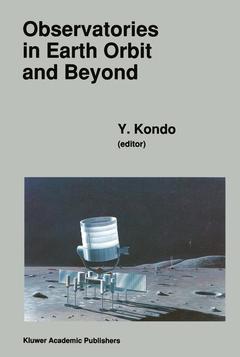Observatories in Earth Orbit and Beyond, 1990 Proceedings of the 123RD Colloquium of the International Astronomical Union, Held in Greenbelt, Maryland, U.S.A., April 24–27,1990 Astrophysics and Space Science Library Series, Vol. 166
Langue : Anglais
Coordonnateur : Kondo Y.

When I became President of International Astronomical Union Commission 44 for the triennial period 1985-1988, several members of the Organizing Committee and I agreed that it would be a good idea for our Commission to host a conference on observatories in space in view of their increasingly important role in astronomi cal research. IAU Colloquium Number 123 "Observatories in Earth Orbit and Beyond" is the first colloquium sponsored by IAU Com mission 44 on Astronomy from Space, although Commission 44 has co-sponsored numerous colloquia and symposia in the past. The past two decades have seen a flourishing of astronomical observatories in space. Over a dozen orbiting observatories have opened up a new window on the universe, providing hitherto una vailable data in the electromagnetic spectral range from gamma-ray, X-ray, ultraviolet to infrared and radio. This has clearly demon strated the crucial nature of astronomical observations from space. The invited talks of present colloquium consist primarily of reviews of currently operating observatories in space, future observatories that have been approved by sponsoring government or space agencies, the launch systems of U.S.A., E.S.A., U.S.S.R. and Japan, discussions of various orbits and sites (such as the Moon), and alternate approaches in designing space observatories. Several panel discus sions addressed those issues as well as the major unsolved problems of astronomy. Contributed poster papers included descriptions of space observatories that are in planning stage.
I. Current Missions.- The Hubble Space Telescope.- Early Results from the Cosmic Background Explorer (COBE).- The Status of the DIRBE Instrument on the COBE.- The Automatic Spacecraft Granat.- The Hipparcos Mission: Will It Be a Scientific Success?.- The International Ultraviolet Explorer (IUE).- X-Ray Astronomy Satellite Ginga.- Extreme and Far Ultraviolet Astronomy from Voyagers 1 and 2.- II. Future Missions.- Röntgen Satellite.- The Gamma-Ray Observatory.- The Advanced X-Ray Astrophysics Facility.- The Astro-D Mission.- The X-Ray Timing Explorer.- The Joint European Telescope for X-Ray Astronomy (JET-X).- SODART Telescope on Spectrum-Röntgen-Gamma and Its Instrumentation.- ESA’s X-Ray Astronomy Mission, XMM.- The SAX Mission for X-Ray Astronomy.- The Extreme Ultraviolet Explorer Mission.- Lyman the Far Ultraviolet Spectroscopic Explorer.- Far and Extreme Ultraviolet Astronomy with Orfeus.- The Spectrum — UV Project.- The Space Infrared Telescope Facility (SIRTF).- The Infrared Space Observatory.- IRTS: Infrared Telescope in Space.- FIRST — Far Infrared and Submillimetre Space Telescope.- A Submillimeter Mission for the 1990s: SMMM.- The Submillimeter Wave Astronomy Satellite.- International VLBI Satellite (IVS).- VSOP, A Space VLBI Programme.- VLBI with TDRSS.- SOHO — An Observatory to Study the Solar Interior and the Solar Atmosphere.- An Overview of the Orbiting Solar Laboratory.- The Planetenteleskop Mission.- The Astrometric Imaging Telescope: Near-Term Discovery and Study of Other Planetary Systems.- Ultraviolet Polarimetry.- The Hopkins Ultraviolet Telescope.- The Ultraviolet Imaging Telescope for Astro 1.- The Broad Band X-Ray Telescope (BBXRT) on Astro-1.- Future Solar System Missions.- The Ulysses Mission in the High Latitude Heliosphere.- ScienceOperations for Future Space Astrophysics Missions.- III. Launch Vehicles.- United States Launch Vehicle Systems.- ESA’s Space Transportation Programme.- Launch Vehicles of ISAS.- U.S.S.R. LAUNCH SYSTEMS 343.- Launch Vehicles of the Future: Earth to Near-Earth Space.- Future Deep Space Propulsion Systems.- IV. Relative Merits of Various Observatories.- Lunar-Based Astronomy.- Relative Merits of Low-Earth, Eccentric, Geosynchronous, and Interplanetary Orbits and Sites in Space.- Humanity or Robotics in Space?.- Astrophysics from the Moon.- Use of Libration-Point Orbits for Space Observatories.- Major Observatories Versus Economy-Class Observatories in Space.- V. Long Term Future Issues.- Does Theory Advance with Technology?.- Occultation Astronomy.- Comments.- The Astrophysics of the Future.- Evolution of the Unsolved Problems.- Contributed Papers.- SIXA: The Solid State Spectrometer Array Onboard Spectrum-X-Gamma.- The X-Ray Large Array.- The Stellar X-Ray Polarimeter for the Spectrum-X-Gamma Mission.- The All-Sky Extragalactic X-Ray Foreground.- A Low Energy Gas Scintillation Proportional Counter for the SAX-X-Ray Astronomy Satellite.- The EXOSAT Results Database.- An X-Ray All Sky Monitor for a Japanese Experimental Module on the Space Station.- The Astro Mission.- The UV Imager for the Israeli Scientific Satellite.- ORFEUS-SPAS: The Berkeley EUV Spectrometer.- An Observatory for Mapping the Far UV Diffuse Galactic Emission Line Background.- Project of a Three Reflection Telescope for Wide Field Ultraviolet Observations.- Santa Maria: An Orbiting Multispectral Observatory.- Cryogenic Testing of Optics for ISOCAM.- EDISON: A Second Generation Infrared Space Observatory.- Merits of Space VLBI Missions for Geodynamics.- Low Frequency Radio Astronomy from Earth Orbit.-High-Resolution Imaging Spectroscopy at TeraHertz Frequencies.- Science Observations with the IUE Using the One Gyro Mode.- New Methods of Determining Spacecraft Attitude.- Knowledge Based Automated Scheduling and Planning Tools for IUE.- Earth Observation System Plans of India.- The Stability of the Planetary Triangular Lagrange Points.- Cosmic Rays and the Dynamic Balance in the Large Magellanic Cloud.- Limitations of Observational Cosmology.- Structure of Radiatively Cooled Jets.- A New Way for Testing of Light Deflection in Earth Orbit or Beyond.- Studying the Galactic Central Engine from Space Observatories.- PARTICIPANTS IAU COLLOQUIUM 123, held in Greenbelt 24–27 April 1990.- Index of Telescopes and Instruments.- Agenda Iau Colloquium No. 123.
Date de parution : 11-2012
Ouvrage de 572 p.
15.5x23.5 cm
Mots-clés :
© 2024 LAVOISIER S.A.S.



